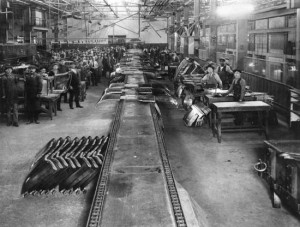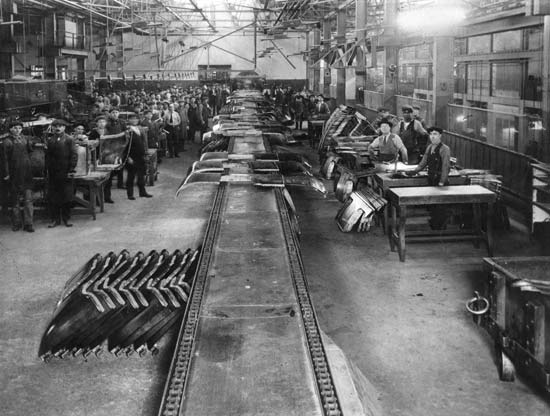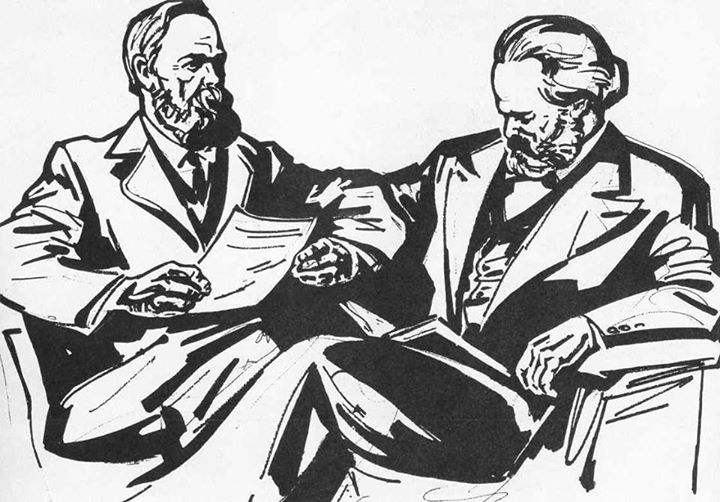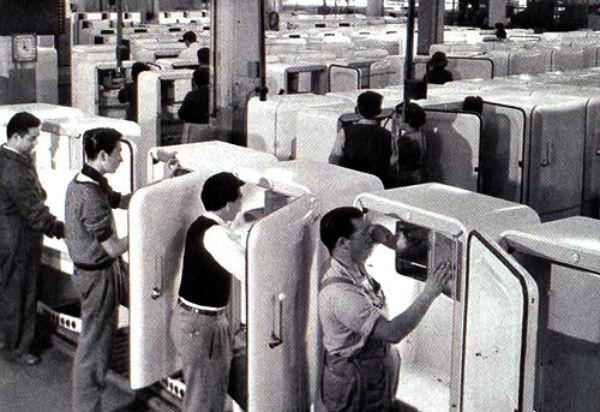 On the development of the automotive industries in Argentina and Brazil and foreign companies.
On the development of the automotive industries in Argentina and Brazil and foreign companies.
By Ianina Harari – (Translated by Leonardo Kosloff)
The theory of imperialism can sometimes be a good excuse to justify ignorance. There have been attempts at explaining the economic problems in countries of late development by imperialist oppression, but which lack the knowledge of how capitalism historically evolved in them. In this way, foreign companies are the agents of this oppression, and their actions would explain all the local shortcomings.
The problem of these conceptions is that foreign companies do not always act in the same form in all countries; hence, the outcome is not always the same. One example is the automotive industry in Argentina and Brazil. In both countries this branch has developed at the mercy of the establishment of foreign capitals. But, while in the first case this industry remained attached to the domestic market, in the second case exports shot up. Let us see how, with the exact opposite arguments, the pseudo-Marxist intellectuals have defended the idea that imperialism hinders national development.
Argentine nationalism
The Argentine automotive industry exists due to the establishment of foreign terminals in the ‘60’s. A widely spread interpretation of this phenomenon is that the quasi-speculative behavior of these companies caused the meager development of the branch. The author who synthesized this position was Jorge Schvarzer [1]. According to him, transnational companies brought in the least necessary amount of capital to the country and did not adapt machinery to the smaller local scale. Schvarzer does not maintain this line of interpretation coherently: in one page, inefficient industries were generated in this form with high excess capacity. But, contradictorily, in another page, he sets out the argument that great efforts were invested in the adaptation of plants to the domestic market. In turn, he points out that the size of the local plants was smaller than that of their headquarters and that production plans were narrow. In his assessment, the latter would demonstrate that they had short-term mentality and a lack of productive attitude. So…, which one is it then?
For Schvarzer, the problem of the plants’ reduced size derived from the denial of foreign companies to embark on exporting ventures, in spite of state policies, to which the terminals were opposed given that the contracts with their headquarters banned them from selling in external markets. Luckily, he saved us the work of refuting this argument, for he does so himself: in the ‘camporist’ epoch exports to Cuba were made, including by terminals such as Ford, which supposedly had it forbidden due to the US blockade on the island. In effect, this possibility was instigated both by terminals as by auto parts makers. The idea that sister companies were opposed to exports is false, since transnational companies like Ford had implemented, beginning in the ‘70s, the policy of promoting exports from their affiliates [2]. Schvarzer reads the process starting from its ulterior results and assumes, even against part of the information he presents, that if exports were not made from Argentina it was because there was no will to do so. In his national-developmentalist dream, the possibility that Argentina was not apt to function as a platform for an exporting automotive industry is absent. As a result, he can only conceive the turn to the domestic market of the affiliate companies as a by-product of speculation and policy of imperialist companies, whose sole desire is to keep underdeveloped countries subjugated.
Brazilian pseudo-Marxism
The development of the neighbor country has been analyzed by a famous dependentist, Ruy Mauro Marini [3], who puts forward that, due to the increase in productivity which is generated with the establishment of foreign companies, there ensues a trend to unemployment which forestalls the creation of a market in line with industrial development. Evidence of this would be afforded by the high levels of excess capacity. Concomitantly, industrialization in Brazil would thereby be centered upon sumptuary goods, beyond the reach of popular consumption. For that reason, these goods would not be part of the value of a super-exploited labor force, since workers would then cease to be part of the market which capitalists are aiming to capture.
The author points out that, in the central countries, the tendency to market contraction through the reduction of workers’ consumption is countered by the adaptation of technology to the domestic market, something which he does not demonstrate, and by the expansion to foreign markets [4]. Marini overestimates the capacity of technological adaptation in the central countries without presenting any evidence. On the other hand, he does not formulate the problem in historical terms. Even if, to some degree, this adaptation to smaller scales were possible over a certain period, this situation would not be feasible for an indefinite amount of time. Because, even without excess capacity, the technology adapted to smaller scales implies, in economic terms, larger total productive costs. Therefore, those capitals which fit this description would be the ones which, once the moment of crisis sets in, would perish against large scale capitals. In addition, his hypotheses do not correspond with what effectively happened in Latin American countries, at least in regards to the automotive industry, one of the main recipients of foreign direct investment. It is not true that the technology utilized in countries of the periphery was not, to a certain extent, adapted to the scale of domestic markets.
Marini considers that Brazil cannot avoid the impact of the increase in productivity over the domestic market because technology would not be controlled by the local bourgeoisie and because the external markets would be dominated by the imperialist countries. Thus, the Brazilian bourgeoisie was obliged to associate itself with imperialist capital offering it the possibility of extraordinary profits, wholly dependent on cheap labor. On this basis, industry would aim at the external markets. This alternative, contrary to the arguments of Argentine nationalists, does take into account the origins of Brazilian adversities.
The neighbor’s always looks better
Both in Argentina and in Brazil, capital was not capable of creating an industry at the level of American industry. But while the Argentine nationalists complain about having been prevented from developing like Brazil, it looks as though Brazilians would have preferred being like Argentina and limit themselves to the internal market. In both visions, imperialist capital seems to guide itself on the premise of maintaining underdevelopment, expressed in the smaller scale plants and productivity, although it is not clear why imperialism chooses different paths in each case.
However, the explanation is actually simpler once the logic of capital is understood. The factories which were created were, in both cases, smaller in size and had backward machinery compared to that of its countries of origin due to size of the market in which they operated. Even if production had been centralized in the hands of a single capital, that is, a monopoly, the average world-scale productivity could not have been achieved. On the other hand, the fact that companies had excess capacity shows that bringing equipment with higher productive capacity to Argentina or Brazil would have been uneconomical.
The search for external markets was an explicit policy of foreign terminals, both in Brazil and Argentina [5]. The countries where this possibility did not prosper were those whose domestic markets were small, as in the Argentinean case, and did not have the necessary productivity to compete even in the Latin American market. Brazil, the then major competitor of Argentina, had a higher productivity given the scale of its factories, which operated in a larger internal market and, therefore, had less costs.
The emptiness left by the lack of analysis of concrete data is supplanted with a mystical and religious appeal to imperialism. In these nationalist perspectives of economics, foreign capitals are “evil” and, by mere opposition, national capitals are “good.” As anyone who can add two and two knows, between capitalists there are no good and evil ones, but simply entrepreneurs who seek to maximize profit on the back of workers. Be they national or foreign, in Argentina, Brazil or the USA, the problem is not solved by removing the foreign bourgeoisie, but the whole bourgeoisie. In this point, lies the difference between the nationalist dreamers and the socialist revolutionaries.
Notes
[1] Schvarzer, Jorge: La industria que supimos conseguir, Ediciones Cooperativas, Bs. As., 2000. Schvarzer, also known as Victor Testa, was a disciple of Milcíades Peña. Peña’s position can be found in ‘Industrialización y clases sociales en la Argentina’, Hyspamerica, Bs.As., 1986. [2] Jenkins, Rhys: “Internationalization of Capital and the Semi-Industrialized Countries: The Case of the Motor Industry”, in Review of Radical Political Economics, Vol. 17, nº 1-2, 1985. [3] Marini, Ruy Mauro: La dialéctica del desarrollo capitalista en Brasil. Subdesarrollo y revolución, Siglo XXI, 1985 y Dialéctica de la dependencia, Ediciones Era, México, 1973. [4] Strictly speaking, this argument is erroneous: the increase in productivity does not necessarily displace workers, as long as total production can increase at a faster rate, as a result of the expansion toward foreign markets or by the expansion of the domestic market. Indeed, the domestic market, in a context of increasing total investment, will expand so that, on one hand, this will generate more demand for the product in question, and on the other, the cheapening of the commodity produced in better technical conditions will make it accessible to new tiers of consumers. [5] This can be seen in the report of the Asociación de Fábricas de Automotores: Los factores que distorsionan la formación de los costos en la industria automotriz, 1969.


